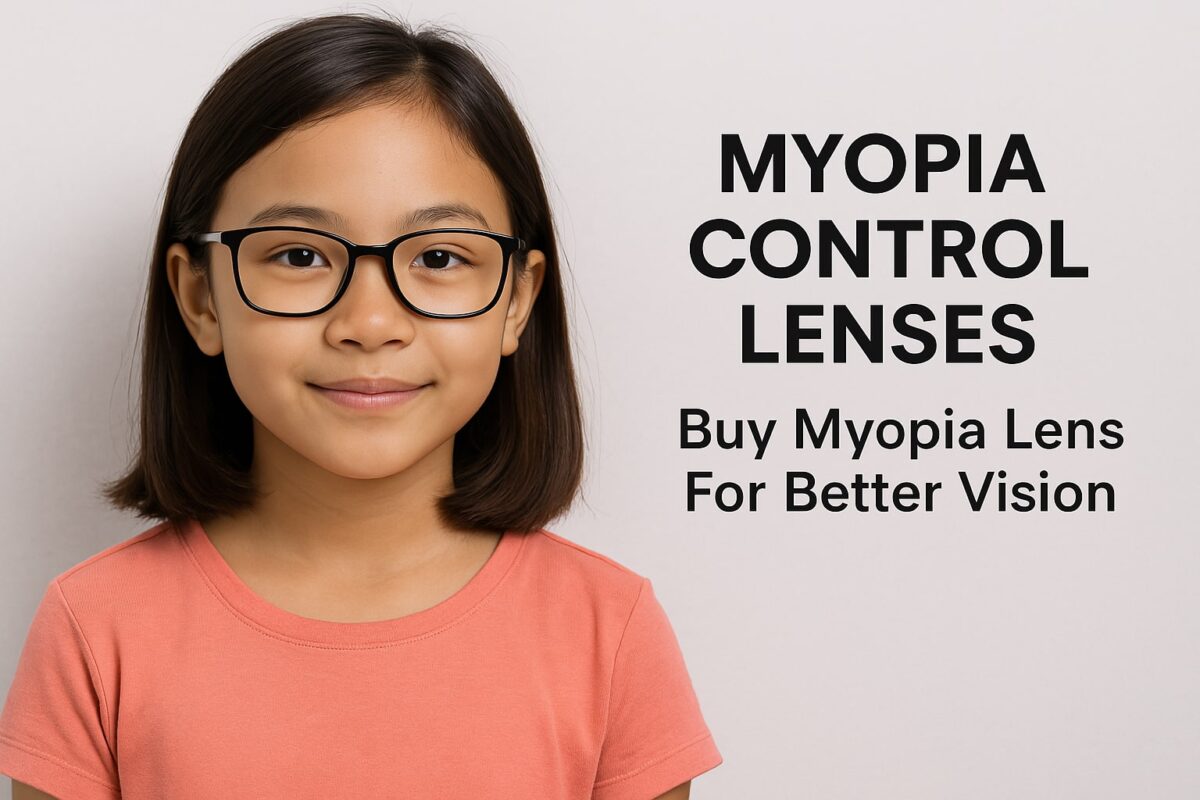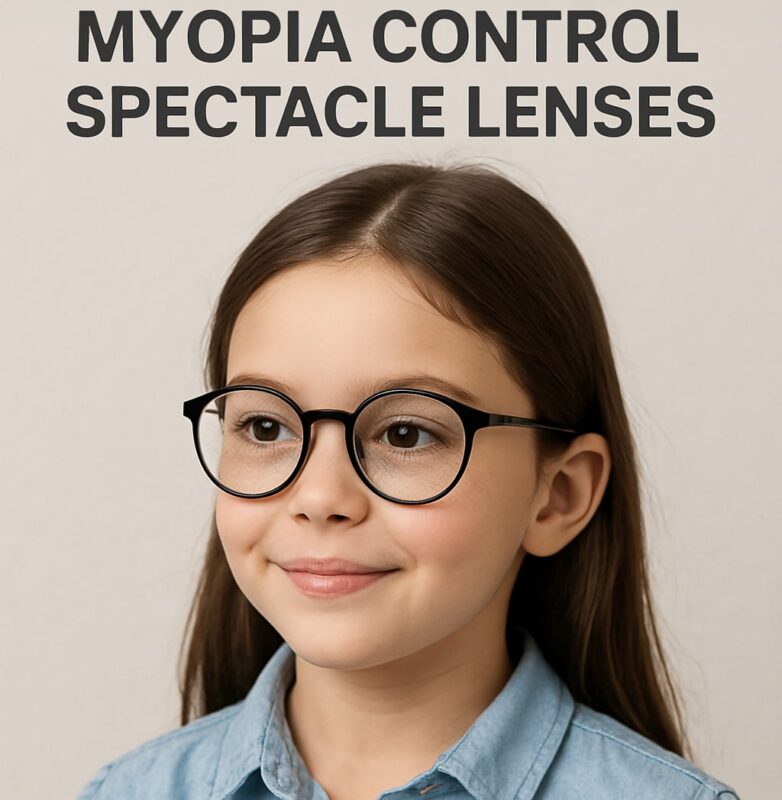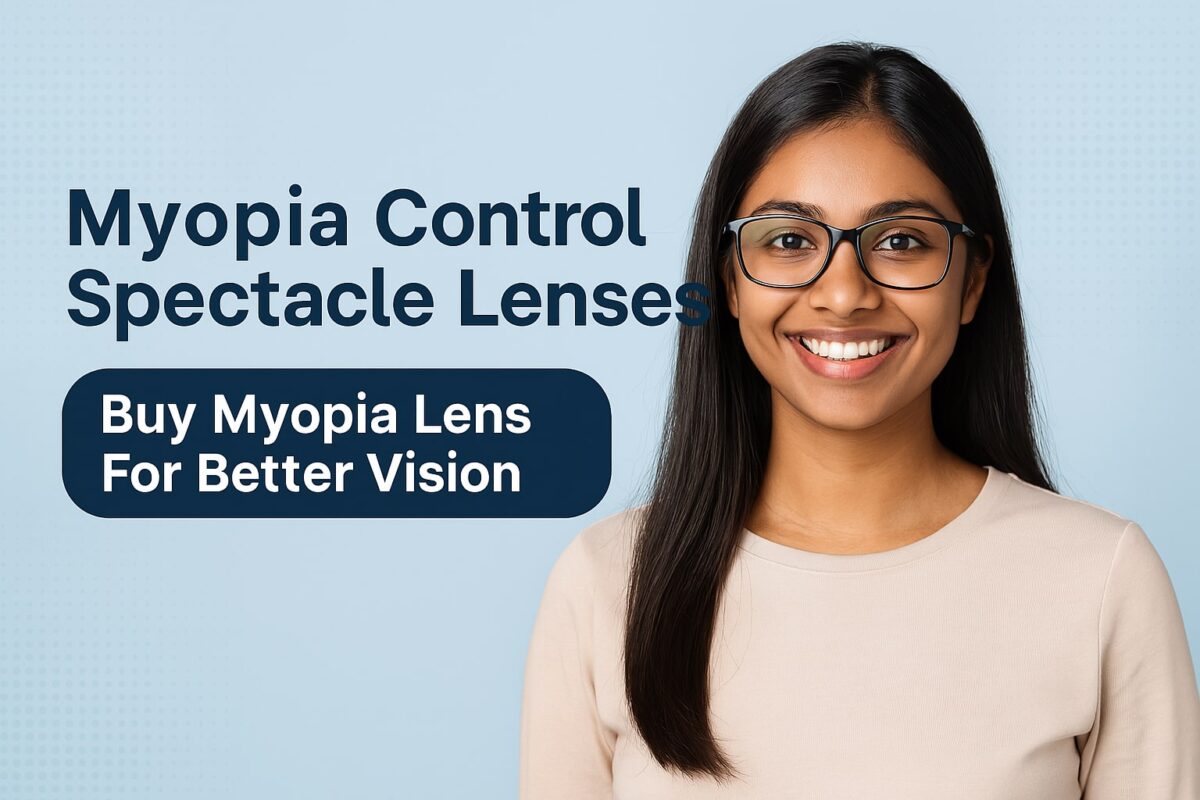Blog
Myopia Control Lenses: What They Are, Who Needs Them, and How They Slow Down Myopia Progression
Myopia control lenses offer a smart way to manage nearsightedness, especially in kids where eye power can keep increasing. These special lenses don’t just correct blurry distance vision like regular glasses—they actively work to slow how fast myopia worsens. If you’re a parent noticing your child squinting at the TV or a teacher spotting kids struggling with the board, understanding myopia control lenses could make a big difference. We’ll dive into what they are, how they function, and why they’re gaining popularity in 2025.
Think of myopia as your eye growing a bit too long, making far-away things fuzzy. Myopia control lenses use clever designs to tweak how light hits the back of your eye, signaling it to grow slower. This isn’t a cure, but studies show they can cut progression by up to 50% in many cases. Whether you’re dealing with mild nearsightedness or worried about high myopia risks like retinal issues, these lenses provide a non-invasive option. Stick around as we explore causes, types, and real tips to get the most out of them.
Myopia control lenses are special eyewear designed to correct vision while slowing eye growth that leads to worsening nearsightedness. They can reduce progression by about half compared to standard lenses, helping kids avoid stronger prescriptions later. Ideal for children aged 6-16, they’re a simple step toward better long-term eye health.
Buy Myopia Control Lenses Contact Us
HRINKAR OPTICALS
What is myopia and why does it matter?
What is myopia? It’s basically nearsightedness, where you see close things clearly but distant objects look blurry. This happens when your eyeball is a tad too long or the cornea curves too sharply, focusing light in front of the retina instead of right on it. It’s super common—over a billion people worldwide deal with it, and numbers are rising fast, especially in kids.
Why should you care? Well, mild myopia might just mean needing glasses, but high myopia ups risks for serious stuff like glaucoma or retinal detachment later in life. Kids with progressing myopia often end up with thicker lenses and more eye strain. Catching it early with options like myopia control lenses can slow that slide, keeping vision sharper for longer. Imagine your child not needing super-strong prescriptions by adulthood—that’s the real win here.
What is myopia in simple terms? Picture trying to read a road sign from afar; it’s fuzzy because your eye’s shape throws off the focus. It’s not just annoying—it can affect school, sports, and even driving safety as you grow up.
What causes myopia?
Myopia causes often mix genetics and lifestyle. If your parents have it, you’re more likely to develop a myopic eye too—studies show genes play a big role, accounting for up to 90% of the risk in some cases. But environment matters a ton. Spending too much time indoors on screens or books without breaks can push your eyes to elongate faster, leading to myopia.
Other myopia causes include limited outdoor time—kids who play outside more seem to have lower rates, possibly from natural light helping regulate eye growth. Urban living and intense near-work, like studying for hours, also contribute. It’s like your eyes adapt to close-up focus but lose out on distance vision. In 2025, with more remote learning, we’re seeing spikes in childhood cases, making early intervention key.
Myopia causes aren’t just one thing; they’re a combo of family history and habits. For instance, if you rarely look at far horizons, your eyes might stretch to compensate, worsening the issue over time.
What is a myopic eye?
A myopic eye is one that’s elongated or has a steeper cornea, causing light to focus incorrectly. In a normal eye, light rays hit the retina perfectly for sharp vision. But in a myopic eye, they converge too soon, blurring distant views while keeping nearby ones clear.
This shape change often starts in childhood and can progress until the late teens. A myopic eye isn’t “bad”—it’s just wired for close-up tasks. However, without management, it can lead to higher prescriptions and eye health risks. Think of it like a camera lens stuck on macro mode; it excels at details but falters on landscapes.
What is a myopic eye compared to a regular one? It’s longer front-to-back, shifting focus points and making far sights hazy.
What lenses are used in myopia correction?

Which lens is used to correct myopia? Typically, concave lenses—thinner in the middle to spread out light rays and push the focus back onto the retina. These are your standard myopia correction lens in glasses or contacts, making distant objects sharp again.
But for progressing cases, myopia control lenses go further. They’re a type of myopia lens with special zones that create peripheral defocus, signaling the eye to slow growth. Myopia can be corrected by using a concave lens basically, but adding control features amps up the benefits. Lens used in myopia might also include contacts for all-day wear, but glasses are often the easiest start.
Lens used in myopia varies: basic concave for correction, advanced ones like DIMS for control. It’s all about bending light right.
How do myopia control lenses work to slow progression?
Myopia control lenses work by creating a dual-focus effect: clear central vision for daily tasks, plus peripheral signals that tell the eye to grow slower. Unlike regular myopia glasses, they use tiny lenslets or diffusers to focus some light in front of the retina, reducing axial elongation—the main driver of worsening myopia.
Studies show this can cut progression by 50% or more over years. For example, wearing them daily prevents the eye from stretching as much, like gently guiding a growing plant. In 2025, tech like AI-adjusted lenses is emerging to fine-tune this even better.
How do these myopia lens options differ from standard ones? They actively manage growth, not just correct vision.
Who should consider myopia control lenses?
Kids aged 6-16 with progressing myopia are prime candidates for myopia control lenses, especially if family history points to high risks. If your child’s prescription jumps yearly, these could help stabilize it. Adults with mild cases might benefit too, though progression usually slows after teens.
Anyone wondering how to reduce eye power should look into them— they’re great for active lifestyles where contacts feel tricky. Consult an eye doc if outdoor time is low or screen use is high, as these factors speed up myopia causes. Myopia control lenses suit most, but not severe cases needing surgery.
Who needs a myopia correction lens with control? Mainly growing kids to curb future issues.
Difference between myopia and hypermetropia: What you need to know
What’s the difference between myopia and hypermetropia? Myopia (nearsightedness) blurs distant objects due to an elongated eye, while hypermetropia (farsightedness) fuzzy close-up views from a shorter eyeball. Myopia needs concave lenses; hypermetropia uses convex ones.
The key difference between myopia and hypermetropia is focus point: too far forward in myopia, too far back in hypermetropia. Both are refractive errors, but myopia hits more kids today. Understanding this helps pick the right myopia lens or treatment.
Difference between myopia and hypermetropia boils down to eye shape—one too long, one too short.
Types of myopia control lenses
Myopia control lenses come in various designs, each tackling eye growth uniquely. From spectacle-based to contacts, they all aim to slow progression while correcting vision.
DIMS lenses: How they work and benefits
DIMS (Defocus Incorporated Multiple Segments) lenses feature hundreds of tiny lenslets that create myopic defocus in peripheral vision, slowing axial growth. They’re like a standard lens with built-in brakes for myopia. Benefits include up to 50% less progression, clear central sight, and easy adaptation for kids.
HALT lenses: Technology and advantages
HALT (Highly Aspherical Lenslet Target) uses aspherical lenslets to reduce myopia by focusing light ahead of the retina. Advantages? Proven in long-term studies to cut progression equivalent to three years’ worth, preventing high myopia. Great for daily wear without side effects.
DOT and CARE lenses: Emerging options
DOT (Diffusion Optics Technology) diffuses peripheral light to control growth, while CARE uses micro-cylinders for similar effects. These are newer, showing promise in early trials for 6-10 year olds. They’re emerging as user-friendly myopia glasses alternatives.
Myopia control glasses vs. soft contact lenses
Myopia control glasses like DIMS offer simplicity—no handling lenses—while soft contacts provide all-day correction and move with the eye for consistent defocus. Glasses suit younger kids; contacts work for active teens. Both slow progression similarly, around 50%.
How to reduce eye power: Can myopia control lenses help?
Wondering how to reduce eye power? Myopia control lenses don’t reverse it but can prevent further increases by slowing eye elongation. Pair them with habits like more outdoor time and the 20-20-20 rule: every 20 minutes, look 20 feet away for 20 seconds.
To reduce eye power, combine lenses with lifestyle tweaks—limit screens, encourage play outside. It’s not instant, but consistent use shows results in months. Myopia can be corrected by using a control lens to stabilize power over time.
How to reduce eye power naturally? Blend myopia control lenses with daily breaks and sunlight exposure.

Common myths about myopia control lenses
One myth: myopia control lenses are just fancy glasses—they actually alter eye growth signals. Another: they’re only for severe cases. Nope, even mild myopic eye benefits from early use. Some think they blur vision; truth is, central clarity stays sharp.
Don’t believe they cure myopia—they manage it. Myths like “outgrowing myopia” ignore how progression continues without intervention.
Understanding different myopia lens type options available today
When exploring myopia lens type choices, it’s important to know that not all options work the same way. Each myopia lens type uses unique technology to address how light enters your eye and signals growth patterns. Understanding the right myopia lens type for your specific needs can make the difference between just correcting vision and actively managing progression.
The most common myopia lens type includes single-vision concave lenses for basic correction, but these don’t slow progression. Advanced myopia lens type options like DIMS, HALT, and DOT go beyond correction by incorporating special zones that create peripheral defocus. This myopia lens type actively works to reduce axial elongation—the main cause of worsening nearsightedness.
For children, the ideal myopia lens type depends on age, lifestyle, and progression rate. Kids aged 6-10 often do well with spectacle-based myopia lens type options like DIMS, while teens might prefer contact lens variants. Adults can benefit from any myopia lens type that addresses their specific visual demands and progression patterns.
Choosing the right myopia lens type for your lifestyle
Your daily activities should influence which myopia lens type you select. Active kids who play sports might need durable spectacle myopia lens type options, while studious teens could benefit from contact lens variants. Each myopia lens type has unique advantages—spectacles offer convenience and safety, while contacts provide consistent optical zones.
The wrong myopia lens type can reduce effectiveness, so proper fitting is crucial. Work with an eye care professional to determine which myopia lens type aligns with your prescription, age, and visual habits. Remember, the best myopia lens type is one you’ll wear consistently every day for maximum progression control.
Real-world tips for using myopia control lenses effectively
Start with a proper fitting—ensure the frame sits right so lens zones align with your gaze. Wear them full-time for best results, like during school and play. Clean daily to avoid smudges that could affect defocus.
Track progress with regular eye checks every six months. For kids, pair with outdoor activities to boost effects. If adapting feels tough, give it a week—most adjust quickly.
Tip: Use myopia glasses for sports; they’re durable and effective.
Combination treatments: Myopia control lenses and low-dose atropine
Pairing myopia control lenses with low-dose atropine drops can supercharge results, slowing progression more than lenses alone. Atropine relaxes eye muscles, complementing the lenses’ optical signals. It’s safe for kids, with minimal side effects like light sensitivity.
Studies show this combo reduces axial elongation by up to 70% in some cases. Talk to your doc for dosing—usually nightly drops.
Latest trends in myopia management for 2025-2026
Trend: AI-smart lenses are rising in 2025, adjusting in real-time to light and activity for personalized control. Forecast for 2026: More hybrid options blending glasses with apps for tracking eye health.
Trend: Gene therapy insights could lead to preventive treatments, combined with lenses. Expect wider access to advanced myopia lens like HAL, with long-term data confirming benefits.
Common mistakes when using myopia control lenses
A big mistake: not wearing them consistently—sporadic use weakens the control effect. Another: skipping eye exams, missing progression signs.
Don’t ignore fit; ill-fitting frames reduce efficacy. Avoid assuming they’re a cure—combine with healthy habits to tackle myopia causes.
Future outlook for myopia control technology
By 2026, expect smarter myopia control lenses with sensors monitoring wear time and alerting via apps. Research points to even better defocus tech, potentially halting progression entirely in early stages.
Global trends show more focus on prevention, with schools promoting outdoor breaks. The future looks brighter for managing myopic eye issues.
FAQs about myopia control lenses
What is myopia?
Myopia is nearsightedness where distant objects appear blurry due to eye shape issues. It affects kids often and can worsen without management.
What causes myopia?
Genetics and too much near-work like screens contribute, plus less outdoor time speeds it up.
Which lens is used to correct myopia?
Concave lenses correct it, but myopia control lenses add features to slow growth.
How do myopia control lenses differ from regular ones?
They include defocus zones to manage progression, not just correct vision.
Difference between myopia and hypermetropia?
Myopia blurs distance; hypermetropia blurs near, due to opposite eye shapes.
Can myopia control lenses reduce eye power?
They slow increases but don’t reverse existing power; use with habits for best results.
Conclusion: Why myopia control lenses could be a game changer for your eyes
Wrapping up, myopia control lenses stand out as a practical way to tackle nearsightedness head-on. They address what is myopia at its root by slowing eye growth, helping avoid the pitfalls of high myopia down the line. If you’ve got a myopic eye or a child showing signs, these lenses offer clear vision today and protection for tomorrow.
Remember, myopia causes like screen time and genetics are on the rise, but options like these make management easier. Whether choosing DIMS, HALT, or emerging types, starting early can make a huge difference. Pair them with tips on how to reduce eye power, and you’re set. Myopia can be corrected by using a myopia correction lens, but control versions take it further. In 2025, with trends like AI integration, myopia control lenses are evolving fast—don’t wait to explore them for healthier eyes.

